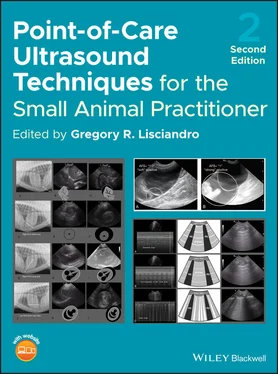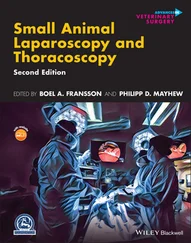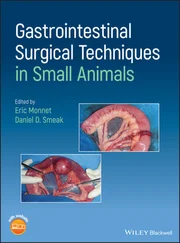We strive to perform the entire Global FAST using the abdominal preset with the same curvilinear (microconvex) probe for the abdomen and thorax, including heart and lung. However, in time the sonographer may come to prefer different presets (cardiac, small parts) and probes (phased‐array, linear), depending on the structure(s) of interest, the stability of the patient and the clinical questions being addressed. However, the curvilinear (microconvex) probe is absolutely acceptable for the entire Global FAST examination.
What POCUS Top Mistakes Can Do
Make the sonographer aware of the most common mistakes which occur during Global FAST image acquisition.
Make the sonographer aware of the most common air and fluid‐associated artifacts and where they commonly occur during Global FAST.
By raising awareness of these mistakes during Global FAST, the sonographer will carry over these principles to other ultrasound studies.
What POCUS Top Mistakes Cannot Do
Cannot replace proper ultrasound training and experience.
For all sonographers performing Global FAST for a basic understanding of how to optimize image acquisition and avoid mistaking artifacts for abnormalities.
Provide a basic understanding of Global FAST ultrasound image acquisition to help accelerate the learning process.
Provide a practical approach for image optimization and artifact identification as they pertain to the standardized examination of Global FAST and its 15 acoustic windows, and to help make your ultrasound interpretation more accurate.
Image Acquisition Mistakes
Not Recognizing Air Trapping
Ultrasound does not transmit through air. Air reflects your ultrasound beam from its path from the probe head to your areas of interest. Optimizing image quality relies on eliminating the phenomenon of “air trapping,” especially the air trapped between the probe head and its contact with the patient’s skin ( Figures 5.1and 5.2). Air trapping is potentially more problematic when not clipping hair, and hair is rarely clipped for Global FAST, AFAST (abdomen), TFAST (pleural cavity, heart, and lung), and Vet BLUE (lung). So be sure to part the hair, part the hair, part the hair! Parting the hair gets the probe in direct opposition to skin and the best image is optimized with the probe head directly on skin, with no hair in between, and with ample acoustic coupling medium. So what do we recommend?
70% isopropyl alcohol helps strip out air and lipids from hair follicles and is used for that reason. We use 70% isopropyl alcohol unless electrical defibrillation is anticipated (it’s a burn/fire hazard in the presence of electrical current and 100% oxygen) followed by alcohol‐based hand sanitizer, a brilliant trick of the trade given to me several years ago by the Mississippi State radiologist Dr Jennifer Gambino. Note that saline and water, although more gentle, lack the aforementioned properties of 70% isopropyl alcohol. Figure 5.1. Wet and part the hair. In (A) the area is wetted without parting the hair. By doing so, the image will not be optimized because of all the air trapping (see Figure 5.2). In (B) the wetted hair is parted to optimize the coupling of the probe head directly to skin to produce the best image in unshaved patients.Source: Courtesy of Dr Gregory Lisciandro, Hill Country Veterinary Specialists and FASTVet.com, Spicewood, TX.
Alcohol‐based hand sanitizer is an excellent coupling medium and has advantages over both 70% isopropyl alcohol and commercially available acoustic coupling gel. Figure 5.2. Air trapping. In (A) the probe head is placed on a wetted mat of fur in which air is trapped between the hairs. Air trapping attenuates the beam by its reflection and scattering of echoes (blue arrows) off the small pockets of air (white circles). In (B) the hair is parted and thus the probe head is coupled directly to the skin for best image acquisition in an unshaved patient. Note all the beam is transmitted with no reflection or scatter of echoes (blue arrows).Source: Courtesy of Dr Gregory Lisciandro, Hill Country Veterinary Specialists and FASTVet.com, Spicewood, TX.
Alcohol‐based hand sanitizer when compared to 70% isopropyl alcohol is not as noxious on skin or indirectly by its fumes. The coldness associated with isopropyl alcohol is not only objectionable to your patient, but also contributes to their cooling (hypothermia) which may be detrimental for a critical patient. The fumes are also problematic for patients placed in closed environments such as an oxygen cage. My personal experience is that our patients associate the coldness with the anticipation of something painful if they have had previous blood draws and catheter placements. Try smaller volumes of 70% isopropyl alcohol and larger amounts of alcohol‐based hand sanitizer.
When compared to acoustic coupling gel, alcohol‐based hand sanitizer not only wipes off your patient more readily than the gooey consistency of commercially available gel but also evaporates off the hair and skin. The final benefit is that your hands are clean after scanning!
Pitfall:Placing the probe on a wetted mat of hair leads to marked air trapping and poor image quality. Part the hair and get the probe head in direct opposition with the skin with an appropriate acoustic coupling medium.
Pearl: The alcohol‐based hand sanitizer is better than 70% isopropyl alcohol because it is not noxious to the patient, either directly on the patient's skin or indirectly via fumes in closed environments. Moreover, alcohol‐based hand sanitizer is not nearly as cooling as 70% alcohol, which can lead to hypothermia especially in smaller and critically ill patients.
Failure to Keep the Patient’s Head and Ultrasound Screen in the Same Sightline
The danger of not having the head of the patient and the ultrasound screen in the same sightline is twofold ( Figure 5.3). First, if the patient decompensates or is critical, you have no idea if they are becoming distressed, cyanotic, having open‐mouth breathing, etc. when you and the technician are focused on the ultrasound screen in the opposite direction to your patient's head. Second, by not having the patient's head and ultrasound screen in the same sightline, you and your assistant are vulnerable, leaving your face, hands, and body open to bites and scratches without defense, while focusing on the screen. And finally, spatial orientation is better learned and established even by experienced sonographers by having the machine and head of the patient in the same sightline, and you will likely be more comfortable rather than craning your neck to look at a screen in an uncomfortable direction.
Your two hands will function differently while scanning. One is your “probe hand” ( Figure 5.4). The probe hand always holds the probe and you may change which hand is your probe hand depending on where and from which side of your patient you are imaging. However, this hand's function is to work the probe. Your other hand is your “helper hand” which is used to palpate external landmarks and physically stabilize the patient or the probe on the patient, which is explained subsequently. Briefly, in standing patients, your helper hand is your “V trough” during TFAST and Vet BLUE, cupping the sternum to keep your patient from swaying (every time you lose contact, you prolong the study, which is not always in the patient's best interest) (see Figure 5.4). While performing AFAST, your helper hand is used to move less haired skin over your probe placement site for such views as the spleno‐renal (SR) and hepato‐renal (HR) in flank areas, and the cysto‐colic (CC). For TFAST recumbent views, the helper hand can lift the sternum off the table top for less weight on the probe head, which allows for finer movements and less pain because of less pressure on your patient's intercostal space. Finally, during Vet BLUE, the acoustic window you acquire may be moved together with skin, dependent on the mobility of your patient's skin, caudal and cranial over intercostal spaces at each Vet BLUE region.
Читать дальше












